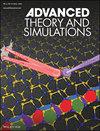Physics of Selective Targeting of Cancer Cells by Magnetoelectric Nanoparticles: Exploring the Role of Conductivity and Capacitance in Tumor‐Specific Attraction
IF 2.9
4区 工程技术
Q1 MULTIDISCIPLINARY SCIENCES
引用次数: 0
Abstract
Magnetoelectric nanoparticles (MENPs) show promise for targeted cancer therapy due to their magnetoelectric properties and selective interaction with biological systems. Experimental evidence highlights their high‐specificity, field‐controlled targeting of cancer cells without bioreagents, yet the physical mechanisms remain unclear. This study explores MENPs’ selective affinity for malignant tissue, focusing on conductivity and capacitance differences. A MATLAB simulation is developed to model MENP interactions with cancer and healthy cell membranes from intravenous injection to targeting. The framework integrated Brownian motion, intermolecular forces—van der Waals attraction, Coulombic repulsion, and dipole image forces—parameterized with literature‐derived electrical properties. Magnetic field effects are simulated in 3D tensor form to assess targeting specificity. MATLAB simulations revealed that MENPs’ surface charge minimizes protein adsorption, enhancing circulation time, while the enhanced permeability retention effect aids tumor accumulation. Cancer cells’ lower negative charge reduces repulsion, enabling closer MENP approach. At short distances, higher membrane capacitance in cancer cells amplifies dipole image forces, increasing attachment compared to healthy cells. Simulated force profiles and particle distributions confirmed a specificity factor favoring cancer cells, enhanced by magnetic modulation. These findings underscore MENPs’ potential for cancer‐specific targeting. The framework provides a theoretical foundation for optimizing MENP design and advancing their therapeutic application.磁电纳米粒子选择性靶向癌细胞的物理学:探讨电导率和电容在肿瘤特异性吸引中的作用
磁电纳米粒子(MENPs)由于其磁电特性和与生物系统的选择性相互作用而显示出靶向癌症治疗的前景。实验证据强调了它们在没有生物反应器的情况下对癌细胞的高特异性、场控靶向,但物理机制尚不清楚。本研究探讨了MENPs对恶性组织的选择性亲和力,重点关注电导率和电容差异。开发了MATLAB仿真来模拟MENP与癌症和健康细胞膜从静脉注射到靶向的相互作用。该框架集成了布朗运动、分子间力——范德华引力、库仑斥力和偶极像力,并用文献推导的电学性质参数化。以三维张量形式模拟磁场效应以评估靶向特异性。MATLAB仿真表明,MENPs的表面电荷使蛋白质吸附最小化,延长了循环时间,而增强的渗透性保留效应有助于肿瘤的积累。癌细胞较低的负电荷减少了斥力,使MENP更接近。在短距离上,癌细胞中较高的膜电容放大了偶极子图像力,与健康细胞相比,增加了附着。模拟的力分布和粒子分布证实了一种有利于癌细胞的特异性因子,通过磁调制增强。这些发现强调了MENPs作为癌症特异性靶向药物的潜力。该框架为优化MENP设计和推进MENP的治疗应用提供了理论基础。
本文章由计算机程序翻译,如有差异,请以英文原文为准。
求助全文
约1分钟内获得全文
求助全文
来源期刊

Advanced Theory and Simulations
Multidisciplinary-Multidisciplinary
CiteScore
5.50
自引率
3.00%
发文量
221
期刊介绍:
Advanced Theory and Simulations is an interdisciplinary, international, English-language journal that publishes high-quality scientific results focusing on the development and application of theoretical methods, modeling and simulation approaches in all natural science and medicine areas, including:
materials, chemistry, condensed matter physics
engineering, energy
life science, biology, medicine
atmospheric/environmental science, climate science
planetary science, astronomy, cosmology
method development, numerical methods, statistics
 求助内容:
求助内容: 应助结果提醒方式:
应助结果提醒方式:


